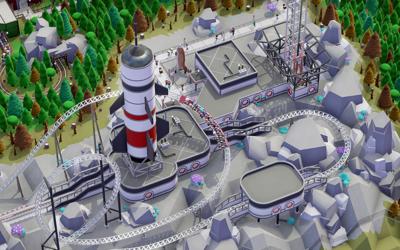In the past few years, I’ve fallen in absolute love with theme parks, going as far as working extra days and stops into Lower 48 trips to maximize the number of rollercoasters along the way. That has included stops at Cedar Point, King’s Island, Worlds of Fun, Busch Gardens, Six Flags, Silver Dollar City and California’s Great America, to name just a few.
I even have a membership card to the American Coaster Enthusiasts sitting on my desk as I write this.
This is all to say, as a member of ACE, I’ve really, really been enjoying the 2018 theme park simulator Parkidect. While plenty of great theme park simulators are out there, Parkidect brings a strong combination of accessible design, creative depth and community to the table in a package still going strong several years after its release.
As the designer of your park, you’re in charge of just about every aspect imaginable. You’ll be laying out paths, hiring park staff, figuring out logistics, building attractions and designing your own rollercoasters. Each situation can be as challenging or as simple as you want, with the game offering everything from designed challenges to a sandbox mode free-for-all.
One of the things you’ll pick up on once you really fall down the coaster rabbit hole is the vast array of rollercoaster types — everything from the wild mouse coasters and mine cart rides to inverted coasters, stand-up coasters and hydraulic launch coasters — out there that each offers their own experience and intensity. Those are represented here with options to design your courses and features, giving you the chance to build some really over-the-top creations.
But designing a really impressive park is far more than just the rides.
That requires good attention to the overall theming of your park, which can be done with Parkidect’s wide range of decorations. The better-themed your park is, the more that park goers will like your park, which results in them spending more money and time there.
But the decoration element of the Parkidect can also feel pretty thin, at least at first.
But that’s where the community aspect of Parkidect has helped give the game a long life. Players can upload and share their own park creations — usually a ride or other feature with accompanying decorations — with other players. The integrated Steam Workshop makes it easy to search and add those to your game in progress — with some particularly impressive recreations of famous rides — and a community voting system allows the best to become a permanent part of the game.
What I really liked about those is that studying the combination of rides and decorations can give you plenty of inspiration and insight on how to build your own dazzling creations using the tools that Parkidect has to offer. The decoration system can certainly feel limited early on, but there are a lot of tricks to maximize the decorations to make a Disneyland-esque level of theming for your park and rides.
For example, you can make some great settings by simply varying the size and rotation of the handful of rocks and boulders that come with the game. You can also change the color and texture of just about any object in the game, which I did when making a volcano theme for my hydraulic launch coaster, loading the area with red, orange and yellow boulders to evoke molten rocks. Then, a neighboring area got blue, teal, and white rocks to mimic a frosty ice zone filled with ice cream shops.
My latest foray into Parkidect has had me explore the game’s multiplayer component, which allows you and your friends to collaborate on the park. I’ve been playing with my partner and brother, with each of us taking turns handling a different aspect of the park whether it be the rides, theming or logistics.
While Parkidect has a friendly and simple approach, there’s a ton of depth here that will keep even the most diehard of coaster fans lining up for another ride.
Platforms: PC (reviewed), MacOS
Release Date: Nov. 29, 2018
Internet: Required for multiplayer, sharing creations
Matt Buxton is a freelance writer and gamer. He can be reached at matt.a.buxton@gmail.com.











